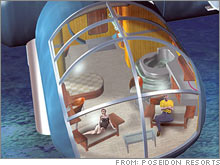Ocean real estate: The next boom?With land getting so crowded, the age-old fantasy of sea-based living is becoming reality. Business 2.0 dives in.(Business 2.0 Magazine) -- We've been promised many things in the world of Tomorrowland: jet packs, flying cars, picnics on the moon. We remember those pledges, ruefully. But with all of our attention on the skies above, we tend to forget about the seas below and another once-popular 21st century prediction: that one day we'll be living on and under the oceans.
 The idea isn't so far-fetched. As Earth gets increasingly crowded and polluted, some 225 million square miles of prime real estate representing 71 percent of the planet's surface is largely unused. It's remarkable considering the oceans promise plenty of living space, fresh seafood, entertainment, and desalinized water. Surely, technology can make this happen. Turns out, it can and it soon will - if not quite the way we first imagined. But before diving into what the near future holds, let's resurface what the distant past once promised. In 1964, at the New York World's Fair, General Motors (Charts) sponsored an exhibit of the "near future." The model featured a city 10,000 feet under the sea, with atomic submarines cruising in and out of the Hotel Atlantis and nearby "Aquacopters" mining for minerals and drilling for oil. Famed oceanographer Jacques Cousteau, meanwhile, was busy chasing his own underwater dreams. His experimental habitat, called Conshelf, was built 85 feet below the ocean's surface and was intended to be the future home of a new human species, dubbed Homo Aquaticus, with gills for lungs. Needless to say, Cousteau's vision ran into some stiff currents. After Conshelf "Aquanauts" complained about lack of light, no privacy, poor appetites, and too much helium in the compressed air, the experiment was abandoned. Then the Space Race took off - and our collective imagination turned to the cosmos. Half a century later, a renaissance of ocean-living dreams is underfoot. The most tangible signs are two altered versions of GM's Hotel Atlantis, at least one of which could be open for business next year. The first is Hydropolis, a $500 million-plus, 220-room hotel under development near Dubai in the Persian Gulf. Billed as the world's first underwater hotel, the Hydropolis will be located, if all goes according to plan, 60 feet below sea level and cost $1,500 a night. Among other amenities, the Hydropolis will also feature a missile defense system to guard against terrorists, a shopping mall, and three bars. Then there's Poseidon Mystery Island, a $200 million development off the coast of Fiji. When it opens in mid-2008, the hotel will be much smaller than Hydropolis and almost twice as expensive to visit. But it does boast something you don't get in Dubai: 24-hour views of one of the world's liveliest coral reefs. Whether these two projects ultimately swim remains to be seen. The engineering challenges aside, there are plenty of unanswered questions about the environmental impact of these underwater havens. And while Poseidon is taking reservations, construction delays at the Hydropolis will likely extend its scheduled 2008 opening. Long term, underwater hotels are a side story. Most of the water-based real estate action of the next decade is likely to be closer to the surface, and closer to land. As my Business 2.0 colleague Jeff Davis notes in his excellent blog about the ocean business, Waterlog, there's a rising tide of architects building floating homes in response to global warming. Sea levels rising by 20 feet over the next 50 years? No problem. Simply surround at-risk cities (like New York) or countries (like Holland) with off-shore waterworlds anchored to the sea floor. Leading this march to the sea is Dutch designer Koen Olthuis. His firm, Waterstudio, is the first to devote itself entirely to waterborne structures - houses, garages, apartment buildings - and has been hired by the Crown Prince of Dubai to build a sail-in mosque, presumably so the legions of oil-rich seafaring Dubains have somewhere to pray on their way to Hydropolis. But perhaps the most novel design for seabound living is the Trilobis 65 from Italian architect Giancarlo Zema. Retailing for $5 million, the oddly egg-shaped Trilobis seems halfway between a giant yacht and a floating home. It's designed for up to six people to live in, and is powered by an environmentally-friendly combination of solar power and hydrogen tanks. You can take your entire home on day-long deep-sea jaunts, then return to the jetty at night and power down. Which may not be exactly how General Motors or Jacques Cousteau imagined the future. But the more watery the world gets, the more likely its rich coastal cities will start transferring themselves into floating homes and Trilobis-like home vehicles. Smart early investments in such strange-looking seabound schemes - like the hippie-built houseboats of Sausalito, Calif. that are now worth millions - may well turn out to reap deep rewards. _______________________________ More from Future Boy: Tech politics: friends on Capitol Hill BMW steps on (the hydrogen) gas To send a letter to the editor about this story, click here. |
Sponsors
|

